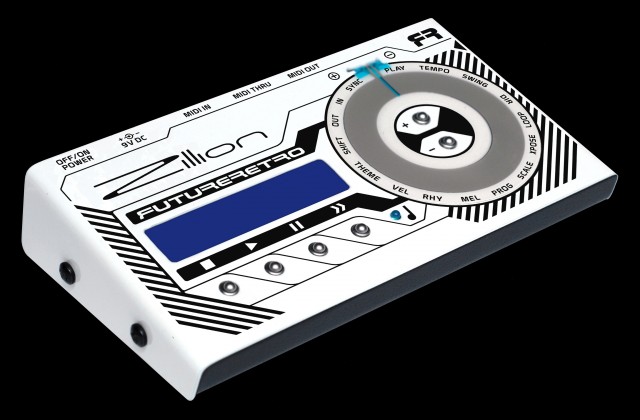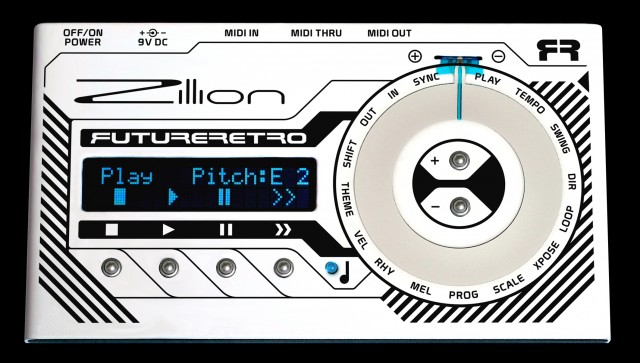
Future Retro has announced the availability of Zillion, a new hardware sequencer, inspired by the rare Triadex Muse algorithmic sequencer.
The Zillion is a single track algorithmic MIDI sequencer based on the principles of the Triadex Muse. The Muse used counters and a shift register to generate more than a million musical melodies. The Zillion expands on these ideas to add more features and functionality, providing a ‘zillion possibilities’.

There are 16 operating modes. These include Playback, Tempo, Swing, Direction, Loop, Transpose, Scale, Scale Program, Melody, Rhythm, Velocity, Theme, Shift Register, MIDI OUT, MIDI IN, and Sync.

Here’s a video overview from the 2014 NAMM Show:
Features:
- The Playback mode allows you to Stop, Start, Restart, Pause, and Manually Step through a sequence.
- The Tempo mode allows you to set the rate the sequence will play back at. The tempo can range from 25-250 BPM. Four hot keys allow you to set and instantly jump from one tempo to another, or can also be changed gradually.
- Swing adds a human feel by delaying the start of every other note by a set percentage. The swing range is from 50-75%. Four hot keys allow you to set and instantly jump from one swing value to another, or can also be changed gradually.
- Four consectutive directions can be entered to determine if the internal counters will increment or decrement, causing a pattern to play forwards or backwards each time a loop point is reached.
- A loop point will cause the internal counters ro reset, limiting the number of steps a pattern will play before repeating. The loop point can range from 1-16 beats, 1, 2, 4, 8, 16, 32, or 64 bars, or can also be set to free-running. Four hot keys allow you to set and instantly jump from one point point to another, or can also be changed gradually..
- Sequences can be transposed by up to 36 semitones within the Transpose mode. Four hot keys allow you to set and instantly jump from one transpose value to another, or can also be changed gradually..
- SCALEThere are 99 Scales that determine what notes the sequencer can generate. Scales 1-16 are presets, while scales 17-99 are user definable. Four hot keys allow you to set and instantly jump from one scale to another, or can also be gradually changed.
- User scales can be programmed with the Zillion’s front panel controls, or using any MIDI controller keyboard. Each scale holds eight pitch values. You can also think of these scales as simple 8-step sequences that can then be “remixed” by the sequencer algorithms. A global tranpose feature is also included in this mode, where any MIDI controller keyboard can be used to tranpose sequences.
- In the Melody mode you can select up to four sources to determine the melody being generated. These sources include counters, shift register outputs, or can also be set simply on or off.
- In the Rhythm mode you can select up to two sources to determine the rhythm being generated. These sources include counters, shift register outputs, or can also be set simply on or off. Rhythms generated will include note-off, note-on (50% duration), note-on (100% duration), or 32nd notes. In addition there is a Rhythm Density value ranging from 0-255. This parameter determines how complex or full the rhythm will be. There are also 3 possible GateTypes to further determine what types of rhythms are generated.
- In the Velocity mode you can select up to four sources to determine a velocity pattern being generated. These sources include counters, shift register outputs, or can also be set simply on or off. This can be a useful parameter for controlling various aspects in an external sound module by simply setting velocity to control that parameter… such as filter cutoff, or VCA amplitude.
- In the Theme mode you can select up to four sources to determine the theme being generated. These sources include counters, shift register outputs, or can also be set simply on or off. The Theme is what feeds the input of the 32 bit shift register. And since sources of the Theme can be outputs of the Shift Register, feedback occurs and the algorithm can take on a life of its own. In addition, when the Melody, Rhythm, or Velocity use the Shift Register as a source, any changes made to the Theme will then affect all parts relying on the Shift Register making for some interesting interactions.
- The Shift Register is a 32 bit logic source for the Melody, Rhythm, Velocity, and Theme. In addition there are 36 parity types available to determine how logic from the Theme will be passed on to the input of the Shift Register.
- The MIDI OUT mode defines the MIDI channel number to transmit data on. Four hot keys allow you to set and instantly jump from one MIDI channel to another, or can also be changed gradually. This then allows you to play different MIDI channels live.
- The MIDI IN mode defines the MIDI channel number to receive data on. Four hot keys allow you to set and instantly jump from one MIDI channel to another, or can also be changed gradually.
- The Sync mode is used to define if the Zillion will play by its internal clock, or sync to an external MIDI clock. In both modes you can determine if the Zillion will transmit MIDI notes, or MIDI notes and MIDI clock.
The Zillion provides the ability to store all parameter settings of where you last were. You can also reset parameters to typical Triadex Muse settings as a quick way of starting new adventures.
Zillion is available now via the Future Retro site for US $300.

Pretty cool. I want to hear some of the sequences with better sounding patches/timbres than the ones in the video.
Yep – I want to know more about how well you can control the chaos.
Like the company’s name, it’s definitely future and retro. Future tech inside, but that 1980s Roland-eque interface would make it hard to understand initially and control, I’d imagine. Menus are so old-school early digital, and that’s not a good thing here. It’d be really nice to have a nice software editor included so that more features could be accessed at once. I really like the idea for generating ideas for off-the-wall sequences, but going back and forth between menus and that tiny display would drive me crazy. Price seems reasonable for something with such deep features.
The website says “The Zillion provides the ability to store all parameter settings of where you last were.” I wonder if you can actually store multiple presets of your creations or not. Otherwise, you’d have to constantly be recording the MIDI stream to your DAW in order to preserve anything worth saving, with no way to recreate the hardware panel parameters of things you liked if you wanted to go back and tweak them months later. Can somebody clear that up, or am I just missing something fundamental here?
seriously, battery power coulda been an easy inclusion, no?
Cool… I’m buying one to primarily control my SidStation.
Sequencers seem to be getting their own resurrenge, the new range of eurorack modules from various companies and now this beauty. Korg micro sq10 please.
How many is a “zillion”, anyway?
+ 1 for the mini SQ10 that would be great. I would have thought there would have to be a market for it based on the success of the ms20 mini.
Try the oberkorn. I think its brilliant. Quantiser would be good though.
That thing is very cool. Good price too.
Where’s euro rack version,???????
Is it a good price? I honestly don’t know. It looks interesting and I kind of want it. I just wonder if this couldn’t be done on an iPad? I understand why analog hardware is valued so highly because of the sound, but if were talking information and programming, I’m confused as to why an app couldn’t do this…and for $12-$19. Sorry to retro-future! I’m not trying to disrespect their product.
I’m wondering how many products they will move VS potential app sales? And, manufacturing cost VS app development? I wonder if an app would have actually been a better business move (regardless of if they want to remain a hardware only company)?
Plus, this will work in 30 years, but good luck on the app. :/ Which is a shame, because there are tons of great apps. And, there are already plenty of apps that just plain no longer work due to not being updated to conform the latest OS release.
I think the majority of people actually stoked to buy this will be hardware guys or those of us that knew about the original Muse. Connectivity is another factor… to utilize Midi and CV, there would need to be some sort of hardware anyway. Lastly, timing on dedicated hardware sequencers is more immediate… with nothing running in the background like an OS or other apps, hardware can focus all its power on a single task.
I love hardware, yet I do not own an ipad…but i see your point. It’s must a midi seq. interface seems too archaic…the fact they were shooting for such a small real estate has forced them to cram a zillion things into a tiny space.
way to small .. to many pages
I think it’s cool. And perhaps only slightly better at sequencing than a monkey banging on the keys.
Misses the whole point. It’s like people who use the Rubik’s Cube as entertainment without a thought for the quantum mechanical processes that it was invented to demonstrate. The Muse is a device for showcasing methods of artificial intelligence in music. This is just a sequencer. BFD.
“Many of the early stories about the Cube related that it was built to teach Rubik’s students how to ”deal with three-dimensional objects.” I never understood what this meant, much less how the Cube could teach it. The mystery was cleared up after I arrived in Budapest. At the Academy they chuckled at the thought of using the Cube in class, and Ru bik dismissed the idea. Yes, he had shown the Cube to his students, but he hadn’t built it for them. He built it because he was a designer who likes playing with geometric shapes. His room in his mother’s two-bedroom apartment was already filled with various cardboard and wooden figures the spring day he attached the elastic strings to the wooden blocks. Although his real interest was the structural problem–how could the blocks move in- dependently without falling apart?–he couldn’t help noticing the way they rearranged themselves as he twisted. By the time the elastic broke he was hooked. But he needed something else to hold the blocks together.
The solution was a brilliantly simple bit of engineering: have the blocks hold themselves together. Rubik painstakingly cut and sanded the little blocks (known today as ”cubies”), assembled them, marked each side of the Cube with adhesive paper of a different color, and started twisting. ” (http://www.puzzlesolver.com/puzzle.php?id=29;page=15)
It was never intended to have anything to do with quantum mechanics.
Yes! Mine has officially shipped today… can’t wait.